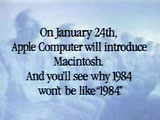
Apple 1984 ad (Photo: Courtesy of Apple)
35 years ago this month on January 22, 1984 the world would get its first preview — in a now iconic commercial that aired during Super Bowl XVIII (18) that year — of a new personal computer from what was then Apple Computer, and two days later, at a community college near the tech company’s original headquarters in Cupertino, California, Apple co-founder Steve Jobs would unveil the Macintosh, a computer that would change the world.

Macintosh 128K (Photo: Courtesy of Apple)
That original Mac was first introduced as the Macintosh with the “128K” added later to distinguish it from its successor the Macintosh 512K. The computer retailed for $2,495 and was, according to the website apple-history.com, the first affordable computer to include a graphical user interface (GUI) and released with much fanfare.
It was a steal at $2,495 despite Apple’s original plans calling for the home computer to be priced at what was then a very cheap $500 – and considering that its predecessor, the Lisa, an Apple computer made for business, in stark contrast, cost a staggering $10,000!
The Macintosh 128K came in an all-in-one compact design — a unique characteristic of most early Macs — and came in a beige case, as was the norm for Apple computers back then and into the late 1990s. It featured a built-in CRT monitor with a black and white 9-inch screen, a 3.5-inch floppy disk drive (which accepted 400K disks), and a keyboard and mouse. Some software titles it came with were MacWrite and MacPaint. And you easily could carry around the Macintosh 128K with its built-in handle on the top rear of the case.
Specifications
Technical specifications of the Macintosh 128K, courtesy of everymac.com, are as follows:
-
- Introduction Date: January 24, 1984
- Discontinued Date: October 1, 1985
- Model No.: M0001
- Dimensions: 13.6″ x 9.6″ x 10.9″
- Weight: 16.5 lb.
- Processor Speed: 8 MHz
- Processor Type: Motorola 68000 (32-bit)
- Standard RAM: 128 KB
- Maximum RAM: 512 KB
- ROM: 64 KB (Macintosh ROM)
- Hard Drive: N/A
- Screen Resolution: 512 x 342
- Installed Mac OS: System 0.97
- Maximum Mac OS: System 3.2
Naming the Macintosh
But where did the name of the iconic Apple computer originate from?

Jef Raskin (Image: Courtesy of Jason Walsh)
While Apple co-founder Steve Jobs is said to have named the company, the Macintosh computer is actually the brainchild of former Apple employee Jef Raskin, a contractor and writer who wrote publications for the company. Raskin was in charge of what was dubbed “the Macintosh project” which was named after his favorite variety of the fruit which he is quoted as saying. The Apple writer would change the name from the original spelling, McIntosh, to the name we all now know and love.
Just think (if you can even fathom the notion) – back in 1984, there were no Apple retail stores, no Apple.com, and that Macintosh 128K was the only Mac the company offered. Fast forward 35 years later, and we have many different Mac models from desktops like the iMac, Mac mini, and MacPro, to notebooks like the MacBook and its Air and Pro versions. (Don’t forget all the different iterations of Mac computers over the past three and a half decades!) Plus, Apple Computer is no more; the word “computer” was dropped from the company’s name by Steve Jobs in 2007 and it became simply Apple, Inc. to reflect its metamorphosis into a consumer electronics company what with the other non-computer products it offers like the assortment of iOS devices from the iPhone, iPad, and iPod touch.
As a final thought on the 35 years of the Mac, it is interesting to note that Steve Jobs and co-founder Steve Wozniak were asked to stop using the name “Apple” for their company because their ad agency said that the brand didn’t imply the power of their computers. (You can read that story over on the Cult of Mac website).
Since the company name begat the Macintosh, had that happened? We would be living in a very different world today: No Apple or the Macintosh; no Mac, either.
keywords: #originalmac #mac128k
short link: https://wp.me/p51SSp-drJ

